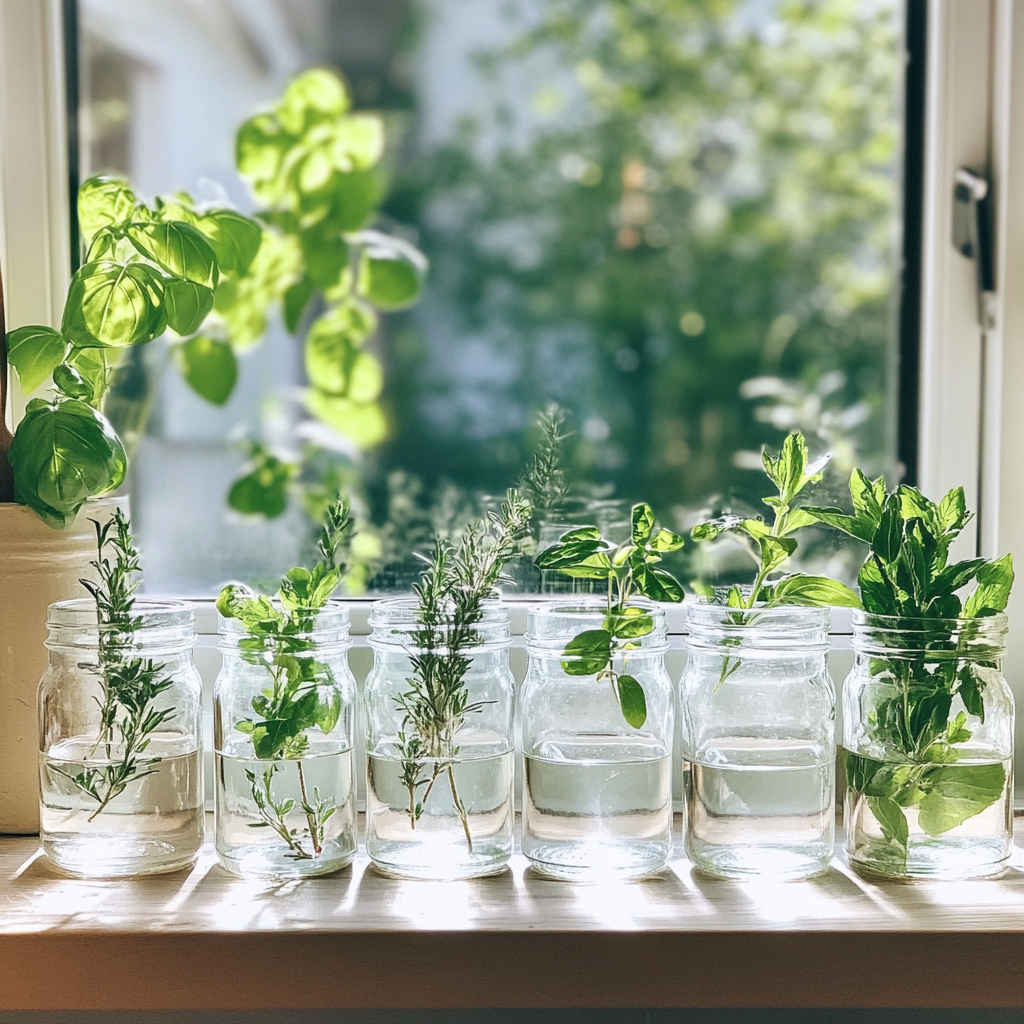Re-growing herbs from scraps is an easy, cost-effective, and sustainable way to enjoy fresh herbs right at home. Whether you’re looking to save money, reduce food waste, or simply start a fun gardening project, this guide will help you transform leftover herb stems into thriving plants. Best of all, some herbs can be grown entirely in water, making this method even more low-maintenance.
---
What You’ll Need
- Herb scraps (from the grocery store or your own garden)
- Glass jars or small containers
- Fresh, clean water
- Potting soil
- Small pots with drainage holes
- Grow light or a sunny windowsill
- Scissors or pruning shears
---
Step-by-Step Instructions for Six Herbs
1. Basil
What to Use: A 3–4-inch stem cutting with leaves removed from the bottom.
Steps:
1. Place the cutting in a jar of water, ensuring the bottom nodes are submerged.
2. Put the jar in a sunny spot with indirect light.
Timeline:
- Root Formation: 7–14 days.
- Transplant to Soil: When roots are at least 2 inches long.
Care:
- Water the soil when it feels dry.
- Keep in bright, indirect sunlight.
Harvesting:
- Snip leaves from the top of the plant to encourage bushy growth.
- Avoid harvesting more than one-third of the plant at a time.
Can Be Grown in Water: Yes. Simply change the water every 2–3 days and keep the jar in indirect sunlight.
---
2. Mint
What to Use: A stem cutting 4–5 inches long with leaves removed from the bottom.
Steps:
1. Submerge the bottom half of the stem in water.
2. Place the jar in a shaded area with indirect light.
Timeline:
- Root Formation: 7–10 days.
- Transplant to Soil: When roots are 1–2 inches long.
Care:
- Keep soil moist but not soggy.
- Mint thrives in partial sunlight.
Harvesting:
- Pinch off leaves as needed.
- Regular harvesting prevents the plant from becoming too woody.
Can Be Grown in Water: Yes. Change the water every 2–3 days to keep the plant healthy.
---
3. Cilantro
What to Use: 2–3-inch stem cuttings.
Steps:
1. Place the cuttings in a glass of water.
2. Keep the jar in a well-lit area, such as a windowsill.
Timeline:
- Root Formation: 7–10 days.
- Transplant to Soil: When roots are 1–2 inches long.
Care:
- Water regularly to keep the soil slightly moist.
- Cilantro prefers cooler temperatures and partial sun.
Harvesting:
- Snip the outermost leaves first to allow the center to grow.
- Avoid harvesting too much at once.
Can Be Grown in Water: Yes, but it will eventually require soil for long-term growth.
---
4. Rosemary
What to Use: A 4–6-inch stem cutting.
Steps:
1. Remove leaves from the bottom two-thirds of the cutting.
2. Place the cutting in water and keep it in bright, indirect light.
Timeline:
- Root Formation: 2–4 weeks.
- Transplant to Soil: When roots are strong and about 1 inch long.
Care:
- Allow the soil to dry out slightly between waterings.
- Place in bright sunlight for 6–8 hours daily.
Harvesting:
- Snip sprigs from the top. Avoid cutting more than one-third of the plant at a time.
Can Be Grown in Water: Yes, but it grows best when transplanted to soil.
---
5. Thyme
What to Use: 3–4-inch stem cuttings.
Steps:
1. Remove leaves from the lower part of the stem.
2. Submerge the stem in water.
Timeline:
- Root Formation: 14–21 days.
- Transplant to Soil: When roots are visible and sturdy.
Care:
- Allow the soil to dry between waterings.
- Place in full sun.
Harvesting:
- Snip small sprigs from the top as needed.
- Harvest before the plant flowers for the best flavor.
Can Be Grown in Water: Yes, though it may require soil for continued growth.
---
6. Green Onions
What to Use: The white base of the onion with roots intact.
Steps:
1. Place the white base in a glass of water with roots submerged.
2. Keep the jar in bright, indirect sunlight.
Timeline:
- Growth: Green shoots will appear in 5–7 days.
- Transplant to Soil (Optional): After 1–2 weeks.
Care:
- Change the water every 2–3 days. If planted, water when the soil feels dry.
- Place in full sun or bright light.
Harvesting:
- Snip the green tops with scissors, leaving the white base intact. New shoots will regrow.
Can Be Grown in Water: Yes, indefinitely, as long as the water is changed regularly.
---
General Tips for All Herbs
- Change Water Regularly: Replace water every 2–3 days to prevent bacterial growth.
- Provide Good Light: Most herbs need 4–6 hours of sunlight daily. Consider grow lights if natural light is limited.
- Fertilize: Use a diluted organic fertilizer once a month for healthy growth.
- Prune Regularly: Frequent harvesting prevents herbs from becoming woody or flowering, which can reduce flavor.
Growing herbs from scraps is not only an easy and rewarding project but also an excellent way to save money and maintain a continuous supply of fresh herbs. Many of these herbs—like basil, mint, green onions, and rosemary—can be grown entirely in water, making them even easier to care for. With just a little effort and maintenance, you can enjoy the satisfaction of growing your own herbs and enhancing your meals with homegrown flavors!
Grab your FREE Printable quick start guide HERE!



Comments ()